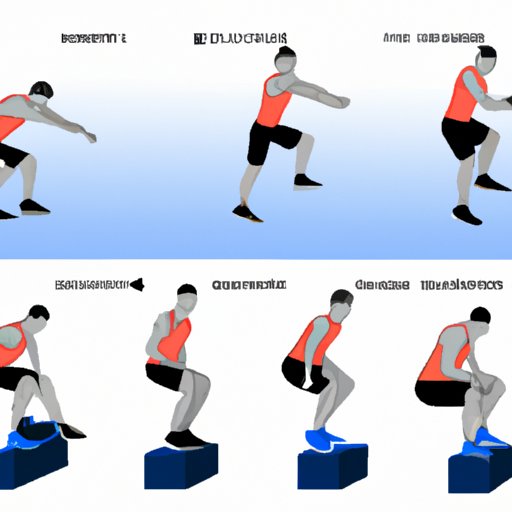Introduction
Plyometric exercises, also known as plyos or jump training, are a form of explosive bodyweight exercises. These exercises involve rapid stretching and contracting of muscles in order to generate power and increase muscular strength and endurance. Plyometric exercises are often used by athletes to improve performance, but they can also be beneficial for those looking to increase their overall fitness level.
A Beginner’s Guide to Plyometric Exercises
Before you begin incorporating plyometric exercises into your workout routine, it’s important to understand what plyos are and how to start with them. Here is a beginner’s guide to help you get started.
What are Plyometrics?
Plyometrics are a type of exercise that involves repeated explosive movements such as jumping, hopping, and bounding. The goal of these exercises is to increase muscle power and speed, as well as to improve coordination and balance. These exercises are often used in sports training, but they can also be beneficial for anyone looking to increase their overall fitness level.
How to Start with Plyos
When starting with plyometrics, it’s important to begin slowly and gradually increase the intensity of your workouts. Start with simple exercises such as jumping jacks and squat jumps and progress to more complex exercises like box jumps and burpees. It’s also important to rest between sets to allow your muscles to recover. Finally, make sure to listen to your body and avoid pushing yourself too hard.
Safety Tips and Precautions
When performing plyometric exercises, it’s important to follow safety guidelines to prevent injury. Make sure to wear appropriate shoes that provide adequate cushioning and support. Warm up your muscles before beginning your workout and cool down after you’re finished. Avoid overtraining by taking regular rest days and increasing the intensity of your workouts gradually. Finally, if you experience any pain or discomfort, stop immediately and consult a doctor.
Plyometric Exercises for Strength and Conditioning
Plyometric exercises can be used to improve strength and conditioning. Different types of plyos can be used to target different muscle groups, so it’s important to choose the right exercises for your goals. Here are some examples of plyometric exercises for strength and conditioning.
Different Types of Plyos
There are several different types of plyometric exercises, each targeting different muscle groups. Lower body plyos target the legs, glutes, and core muscles, while upper body plyos focus on the arms, chest, and back. Core plyos target the abdominal muscles, and balance plyos focus on improving balance and coordination.
Examples of Plyometric Exercises for Strength
Lower body plyos include squat jumps, lunge jumps, and single-leg hops. Upper body plyos include push-ups, clap push-ups, and medicine ball throws. Core plyos include mountain climbers, plank jumps, and tuck jumps. Balance plyos include single-leg stands, single-leg hops, and lateral jumps.

The Benefits of Plyo Exercises
Plyometric exercises can offer a variety of benefits, including improved muscular strength and power, increased speed and agility, and improved balance and coordination. Let’s take a closer look at the benefits of plyo exercises.
Improved Muscular Strength and Power
Plyometric exercises can help to build muscle strength and power. The explosive movements involved in plyos engage multiple muscle groups simultaneously, helping to increase muscle size and strength. This can lead to improved performance in sports and other physical activities.
Increased Speed and Agility
Plyometric exercises can also help to improve speed and agility. The rapid movements involved in plyos help to improve reaction time, which can make you faster on the field or court. Plyos can also help to improve coordination, making it easier to move quickly and accurately.
Improved Balance and Coordination
Plyometric exercises can also help to improve balance and coordination. The explosive movements involved in plyos help to strengthen the muscles and joints, making it easier to maintain balance and control. This can help to improve performance in sports and other physical activities.
Plyometric Exercises for Athletes
Plyometric exercises can be especially beneficial for athletes. Plyos can help to improve performance in specific sports, as well as to reduce the risk of injuries. Here are some tips for incorporating plyos into your workout.
Plyos for Specific Sports
Plyos can be tailored to specific sports to help improve performance. For example, basketball players may benefit from plyometric exercises that focus on jumping, while soccer players may benefit from exercises that focus on quick changes of direction. It’s important to choose exercises that are specific to your sport to ensure maximum benefit.
Examples of Plyometric Exercises for Athletes
Examples of plyometric exercises for athletes include lateral bounds, depth jumps, and skater jumps. Lateral bounds involve jumping side to side and can be used to improve agility. Depth jumps involve jumping off a platform and can be used to increase power. Skater jumps involve jumping from one leg to the other and can be used to improve coordination.

How to Incorporate Plyometrics into Your Workout
Incorporating plyometrics into your workout routine can help to improve strength and conditioning. Here are some tips for planning and executing a plyometric workout.
Planning Your Plyometric Workout
Before beginning a plyometric workout, it’s important to plan ahead. Choose exercises that are appropriate for your fitness level and goals. Also, make sure to warm up your muscles before beginning your workout and cool down after you’re finished. Finally, it’s important to take regular rest days to allow your muscles to recover.
Guidelines for Intensity and Volume
It’s important to follow guidelines for intensity and volume when performing plyometric exercises. Start with low-intensity exercises and gradually increase the intensity as you become more comfortable with the movements. As for volume, it’s best to start with two to three sets of each exercise and gradually increase the number of sets as you become more experienced.
Examples of Plyometric Exercises
Here are some examples of plyometric exercises for the lower body, upper body, and core.
Lower Body Plyometrics
Lower body plyos include squat jumps, lunge jumps, single-leg hops, and box jumps. Squat jumps involve jumping from a squat position and can help to improve power and speed. Lunge jumps involve jumping from a lunge position and can help to strengthen the glutes and hamstrings. Single-leg hops involve hopping on one leg and can help to improve coordination and balance. Box jumps involve jumping onto a box and can help to increase power and explosiveness.
Upper Body Plyometrics
Upper body plyos include push-ups, clap push-ups, medicine ball throws, and burpees. Push-ups involve pushing your body off the ground and can help to strengthen the chest and triceps. Clap push-ups involve clapping your hands between each rep and can help to increase power. Medicine ball throws involve throwing a medicine ball and can help to increase power and explosiveness. Burpees involve jumping from a standing position and can help to improve power, speed, and coordination.

Plyometric Exercises for Improved Balance and Coordination
Plyometric exercises can also be used to improve balance and coordination. Examples of balance plyos include single-leg stands, single-leg hops, and lateral jumps. Single-leg stands involve standing on one leg and can help to improve balance. Single-leg hops involve hopping on one leg and can help to improve coordination. Lateral jumps involve jumping from side to side and can help to improve agility.
Conclusion
Plyometric exercises can offer numerous benefits, including improved muscular strength and power, increased speed and agility, and improved balance and coordination. They can also be tailored to specific sports to help improve performance. When incorporating plyos into your workout routine, it’s important to start slowly and gradually increase the intensity as you become more comfortable with the movements. With proper planning and execution, plyometric exercises can help you reach your fitness goals.
(Note: Is this article not meeting your expectations? Do you have knowledge or insights to share? Unlock new opportunities and expand your reach by joining our authors team. Click Registration to join us and share your expertise with our readers.)
